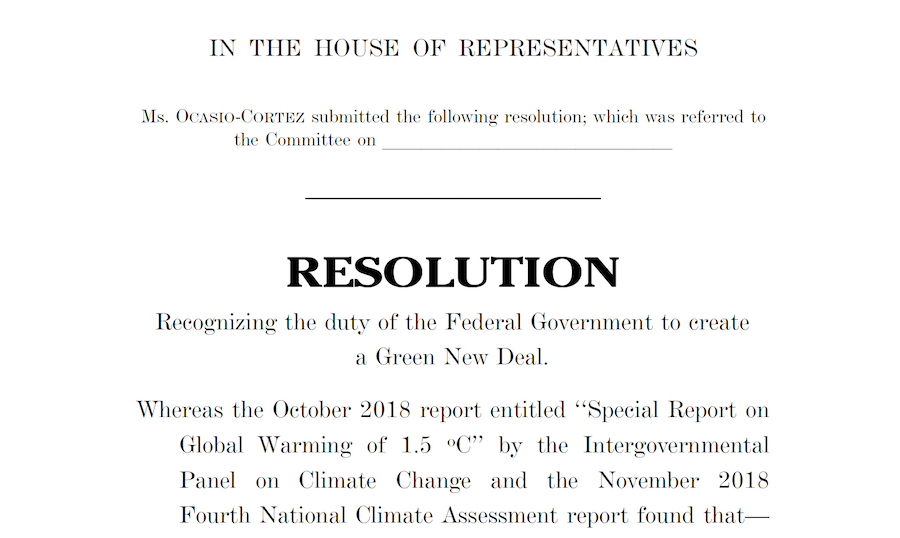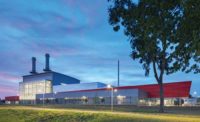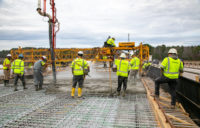A group of congressional Democrats have issued an outline for an ambitious “Green New Deal,” a plan that aims to slow or reverse climate change by a variety of steps, including revamping energy generation, fortifying infrastructure against storms and renovating energy-inefficient buildings.
Odds that the Green New Deal proposal will become law appear long. But, depending on how much support it eventually generates, the plan may help shape the contours of any major infrastructure legislation this year and also push climate change up the list of priority issues for the 2020 elections.
Jimmy Christianson, Associated General Contractors of America vice president for government relations, said in an interview on Feb. 11, "The Green New Deal—if there wasn't already a signal—is an even louder signal that the progressive wing of the Democratic party in the House is going to demand some degree of climate change legislation as a part of any infrastructure bill." That would apply o wide-ranging infrastructure measures and more narrowlly targeted authorization bills, Christianson said.
The blueprint, set down in a proposed resolution introduced in the House and Senate on Feb. 7, has the tenor of a call to political arms. And by design, its authors say, doesn’t specify how much funding it would require—though the price tag would undoubtedly be immense—or identify revenue-raisers to pay for that spending. It does set a timetable, saying that the program should be carried out through "a 10-year national mobilization."
Its prime mover in the House, high-profile, first-year Rep. Alexandria Ocasio-Cortez (D-N.Y.), said at a Feb. 7 press conference outside the U.S. Capitol that the resolution is an initial action. “Our first step,” she said,” is to define the problem and define the scope of the solution.”
The House version had 67 co-sponsors as of its rollout day. That’s far short of a majority but it is still early in the process.
The Senate version, introduced by Ed Markey (D-Mass.), had 11 co-sponsors as of Day One. Minority Leader Chuck Schumer (D-N.Y.) isn’t among them.
But the list does include all of the senators who, to date, have declared themselves as presidential candidates for 2020. That would support Markey’s comment at the press conference that dealing with climate change is “a voting issue” in the U.S. and will be a prime topic in the 2020 election cycle.
House Speaker Nancy Pelosi (D-Calif.) told reporters at a briefing earlier in the day that she welcomed the proposal, though she hadn’t yet read the resolution. Pelosi also said that as Congress pursues infrastructure legislation, one of her stated goals, “we want to do so in a green, informed way.”
But it was a less-than-wholehearted endorsement. She called the Green New Deal “enthusiastic,” adding that “we welcome all the enthusiasms that are out there.”
Union leader, GOP Senator react
One construction labor leader, Terry O'Sullivan, General President of the Laborers' International Union of North America (LIUNA), sharply criticized the Green New Deal. In a Feb. 7 statement, O'Sulivan said, "Attaching a laundry list of laudable proposals unrelated to climate change—proposals which LIUNA and other progressive organizations have long fought for—to the sails of fantasy ensures that they all go down on a sinking ship."
He added, "Infrastructure issues must be addressed in infrastructure legislation, while climate issues must be addressed through climate legislation."
As for Republicans, Environment and Public Works Committee Chairman John Barrasso (R-Wyo.), in a statement, blasted the plan “a raw deal for the American taxpayer” and said it would mean “a Washington takeover of our nation’s energy system.”
Barrasso declared, “It’s the first step down a dark path to socialism.”
Electric-power goal
The resolution sets a goal of “net-zero greenhouse gas emissions” while creating “millions of good, high-wage jobs.” It pledges “to invest in the infrastructure and industry of the United States to sustainably meet the challenges of the 21st century."
A chief goal is to have all U.S. electric power come from “clean, renewable and zero-emission sources” by expanding renewables as well as building or revamping power grids to be more energy efficient. Markey said the resolution is “silent” about individual types of technology.
One dramatic provision is “upgrading all existing buildings in the United States and building new buildings to achieve maximum energy efficiency, water efficiency, safety, affordability, comfort and durability, including through electrification.”
Other aims include ensuring clean air and water, “climate and community resiliency” and “a sustainable environment.”
Steps to reach those goals include “leveraging funding and providing investments for community-defined projects and strategies” to make facilities better able to withstand “climate change-related disasters.”
It also calls for “repairing and upgrading” U.S. infrastructure, including eliminating greenhouse-gas emissions “as much as technologically feasible.”
Transportation also is covered in the proposal. The resolution seeks to create “zero-emission vehicle infrastructure, as well as “clean, affordable and accessible public transit,” as well as high-speed rail lines.
Story updated on 2/12/19 with number of House measure's co-sponsors and comment from Associated General Contractors of America.
Story corrected on 2/8/2019. Plan does include a 10-year timetable






Post a comment to this article
Report Abusive Comment